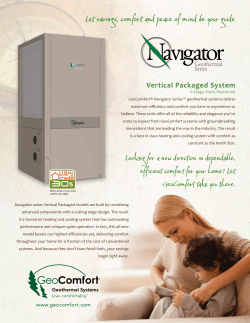
Fact Sheet: Aged Care Facilities
NEEN FACT SHEET Energy Efficiency: Aged Care This fact sheet looks at common types of energy consuming equipment found in aged care facilities. This will help you identify energy efficiency opportunities in your facility. Energy consumption in aged care facilities can contribute significantly to operatings costs. In Australia, approximately 7.8 million gigajoules of energy is consumed by aged care facilities every year. This is comparable to the entire output from some gas-fired power stations. Why does energy efficiency in Aged Care facilities matter? Keeping costs low is a major priority for businesses operating in this sector, as many operate in a very low margin environment. Set against this backdrop are the ever-increasing unit costs for energy use and an ageing population in Australia – many of whom energy-intensive assistance. Reducing energy costs can have a significant impact on lowering operating costs, thereby showing greatly improved margins for most businesses in this sector. Figure 1. Energy consumption profile of an aged care facility Energy consumption in Aged Care facilities Heating and Cooling electricity 27% Energy consumption in aged care facilities tends to be highest in the following areas: • Heating and cooling • Hot water • Lighting Other equipment electricity 17% Hot Water - gas 21% The typical breakdown is graphically illustrated in the pie chart shown opposite. Typically, areas with the greatest energy savings potential will be contained within the largest ‘slices’ of the pie. Heating - gas Kitchen - gas Laundry clothes 3% 4% dryers - gas 11% Lighting electricity 17% Energy saving opportunities There are two key areas where savings can be made: National Energy Efficiency Network • uick wins – these are areas that can be addressed at no or Q low cost almost straight away • trategic – those areas which are more complex, or require S more capital investment www.neen.org.au April 2015 Quick wins • urn lights off – Turn off lights when you are away from a room for more T than ten minutes. • ptimise temperature settings in each area – This will minimise the O amount of heating/cooling required. • Optimise temperature settings of hot water generation – Typically, hot water systems have their temperature set very high to prevent bacteria build-up. However, many people set this temperature much higher than required, to introduce a “safety factor” that is not always needed. • tandby power consumption – Many electrical appliances in the aged S care sector tend to be left on all of the time. Although this equipment generally goes into standby mode when not used for a period of time, this can still have a substantial energy cost. This is generally a very small amount of power consumption, but this small consumption when multiplied over 24 hours, 365 days per year, turns into a large amount of energy use. To prevent this, either manually switch appliances off at the wall, or use smart switches that sense standby mode and automatically shut off power. Strategic opportunities The following energy saving projects are worth considering at aged care facilities: Lighting upgrade Upgrade to more efficient lighting solutions where older lighting technology exists. Lighting upgrades in this instance can consist of fitting new reflectors, new ballasts or new entire luminaires. It can also include improved controls, improving use of daylight and delamping. Refer to the NEEN lighting fact sheet for more information. Insulation/draught-proofing/shading Heating/cooling is generally accepted as the largest energy consumer in this sector, so it makes good sense to minimise heat gains/losses. Improved insulation can reduce energy requirements for heating/cooling by as much as 25%. In colder climates, draught proofing can reduce heating requirements by as much as 40%. Providing shade by planting a tree outside a window can help reduce solar National Energy Efficiency Network heat gain in summer by nearly 70%. Economy cycle Installation of additional external temperature and humidity sensors, as well as motorised dampers and extra fans, can help to reduce air conditioning costs. An Economy cycle on an air conditioning system uses outside air to cool down the inside of a building whenever the external temperature is cooler than it is inside. Upgrade cooling systems Many cooling systems in the aged care sector, such as air conditioning units, are old technology. There are many systems on the market today that are more efficient. If you have an older system, it is worthwhile considering an upgrade based on energy savings (as well as a need to replace certain types of refrigerant gas – for example, if you have a system that uses R22 gas, this must be replaced by 2015). Timers, sensors and motion control Use programmable timers, daylight sensors or movement sensors to control lighting, heating, cooling, ventilation and dispensing systems. Efficient appliances Many older electrical appliances such as televisions, stereos, fridges, freezers, and washing machines are inefficient. Recent advancement in technology has seen many improvements in the efficiency of www.neen.org.au these appliances. Look for energy ratings labels which rate the appliance from one to six stars. The higher number of stars, the less energy it takes to do the same job. Solar hot water Solar water heating is the most energyefficient means of heating water. This is where the water is pumped through coils which are heated by the sun, before being stored in a storage cylinder (all of which is generally situated on the property roof). Booster heat is typically required to raise this water to the required temperature (e.g. on cloudy days or at night). Gas boosting should be used in preference to electric boosting where this is available. Solar hot water systems can also attract Small-scale Technology Certificates – which can be sold for cash, effectively meaning that the capital cost to install these systems is greatly reduced. Solar power (Photovoltaics) Australia is blessed with an abundance of sunlight. Solar panels can convert this sunlight into electricity. This electricity can then be stored in batteries (for offgrid sites), or converted to grid electricity and either used at the site, or sold back to the electricity supplier. Solar photovoltaic systems can also attract Small-scale Technology Certificates – which can be sold for cash, effectively meaning that the capital cost to install these systems is greatly reduced. Refer to the NEEN solar PV fact sheet for more information. Kitchen ventilation Exhaust fans in kitchen areas can consume large amounts of energy. Ensure these are switched off when not in use. For additional savings, a variable speed drive can reduce the speed of the fan motor to suit the correct extraction requirements. Refrigerators/freezers This consists of standalone refrigerators, freezers, display cabinets, cold storage rooms and freezer rooms. This equipment can consume a significant amount of energy – particularly if poorly maintained. Regular maintenance of these items should include: checking of door seals, cleaning of condenser and evaporator coils and checking of temperature sensors. April 2015 Case study – Multicultural Aged Care Services, Geelongg The Multicultural Aged Care Services Geelong Inc (MACS) has completed a number of improvements to reduce the energy use of their building, after received funding from “Future proofing Geelong” and completing an energy assessment. The assessment identified a number of opportunities for reducing the organisation’s energy costs and lowering their carbon emissions by 25%. MACS decided to act on all of the eight recommendations in the assessment report. The works included upgrading lighting to LED globes, automatic switching systems plus insulation of external door surrounds. MACS plan to monitor the outcomes, with a follow up energy assessment in a year’s time, and then present on the findings and outcomes for residents and staff to other aged care providers in the region/state. Useful links NSW Office of Environment and Heritage Energy Saver – Aged Care Toolkit http://www.environment.nsw.gov.au/resources/ business/120602-aged-care-toolkit.pdf Multicultural Aged Care Services Geelong Information on case study http://www.geelongaustralia.com.au/news/ item/8cfe2dd98f36315.aspx where to next? Collate your gas and electricity bills from the last 12 months. Enter your energy data into the NEEN calculator tool. Explore the NEEN website for more information. for further information NEEN – National Energy Efficiency Network NEEN is a national initiative to promote open learning and collaboration amongst faith-based and not-for-profit community organisations, with the aim of increasing energy efficiency and establishing a positive energy future for the sector. What makes the NEEN initiative so powerful? NEEN provides small to medium sized community organisations with the resources to reduce energy consumption and the opportunity to connect and collaborate on a range of initiatives that foster a resilient, sustainable future for the not-forprofit sector and the communities they serve. An Open Invitation No matter where you are on your journey to achieve your sustainability goals, you’re welcome to join the NEEN community. Make the connection and discover a better energy future for your organisation. Acknowledgements This project was funded by the Australian Government – Dept of Industry – Energy Efficiency Information Grant Program. The Level 1 Energy audits and opportunities assessments were carried out by Energetics on behalf of the NEEN program. Disclaimer The information contained in this document is of a general nature only and does not constitute personal financial product advice. In preparing the advice no account was taken of the objectives, financial situation or needs of any particular person. Therefore, before making any decision, readers should seek professional advice from a professional adviser to help you consider the appropriateness of the advice with regard to your particular objectives, financial situation and needs. Government Disclaimer This Activity received funding from the Department of Industry as part of the Energy Efficiency Information Grants Program. The views expressed herein are not necessarily the views of the Commonwealth of Australia, and the Commonwealth does not accept responsibility for any information or advice contained herein. Connect, discover, collaborate, transform www.neen.org.au National Energy Efficiency Network www.neen.org.au April 2015
© Copyright 2025











